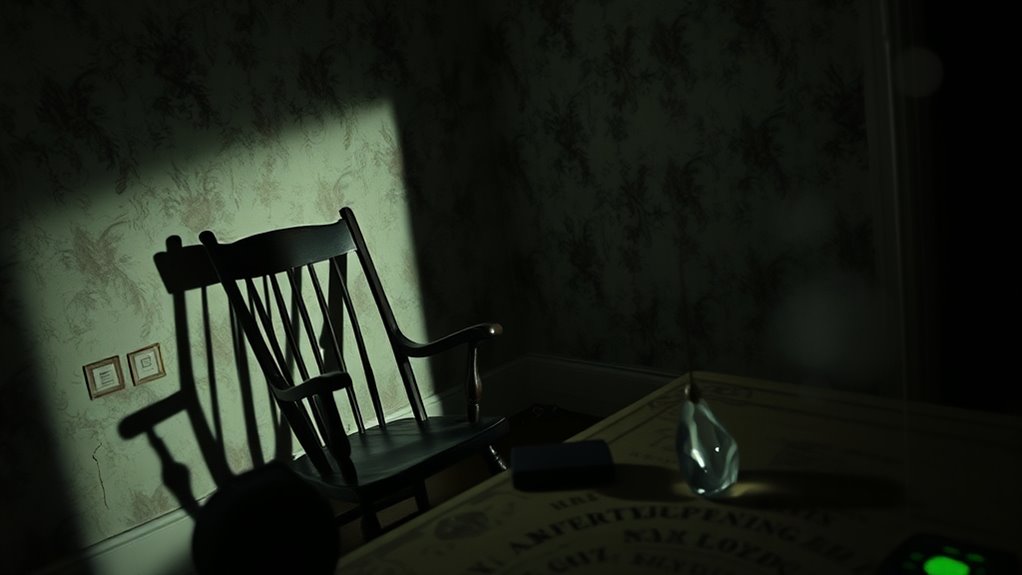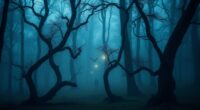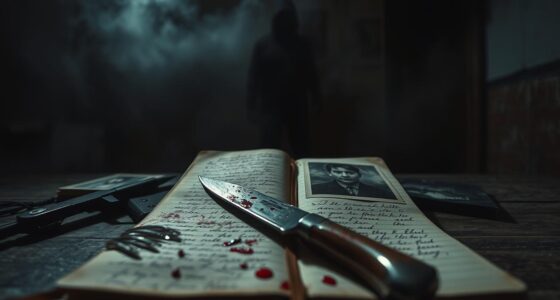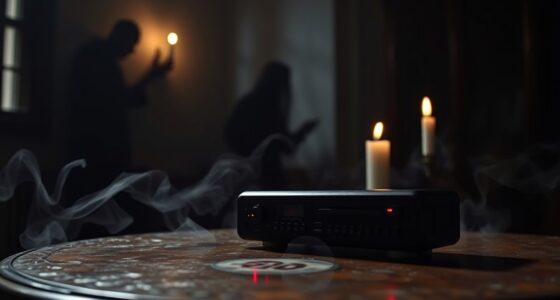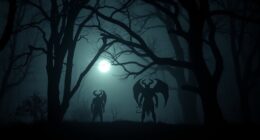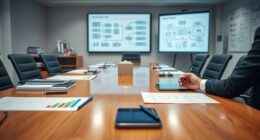To test for paranormal activity, you’ll first document disturbances by noting occurrences like cold spots and unexplained noises. Disproving potential non-paranormal causes is essential, so check for drafts or external sounds. Set up motion-sensitive cameras and conduct EVP sessions to capture audio evidence. Analyzing patterns in the data is key. Utilizing advanced equipment like thermal cameras enhances your investigation. You’ll uncover fascinating insights and techniques to effectively gather evidence and understand the phenomena.
Key Takeaways
- Document disturbances meticulously, including times, locations, and specific sensations, to identify patterns and enhance evidence credibility.
- Disprove potential non-paranormal explanations by investigating environmental factors like drafts or settling noises.
- Conduct EVP sessions using high-quality audio recorders, asking clear questions and analyzing recordings for unexplained voices.
- Capture visual evidence with thermal cameras and motion-sensitive video to document anomalies and validate paranormal claims.
- Utilize advanced equipment such as EMF detectors and spirit boxes to measure environmental influences and facilitate communication with possible spirits.
Documenting Disturbances

When you’re trying to identify paranormal activity in your home, documenting disturbances is essential.
Start by creating a thorough list of occurrences, noting specific sensations like cold spots, chills, or unexplained noises. Record each disturbance with precise times and locations to help identify patterns or recurring incidents.
This detailed account not only assists in your investigation but also serves as a reference for disproving potential non-paranormal explanations. Don’t forget to note environmental factors, like drafts or sounds from appliances, to differentiate between natural and supernatural phenomena.
Maintaining an organized record enhances the credibility of your evidence and aids in evaluating any claims of the paranormal. This methodical approach will help you understand what’s really happening in your space.
Disproving Disturbances
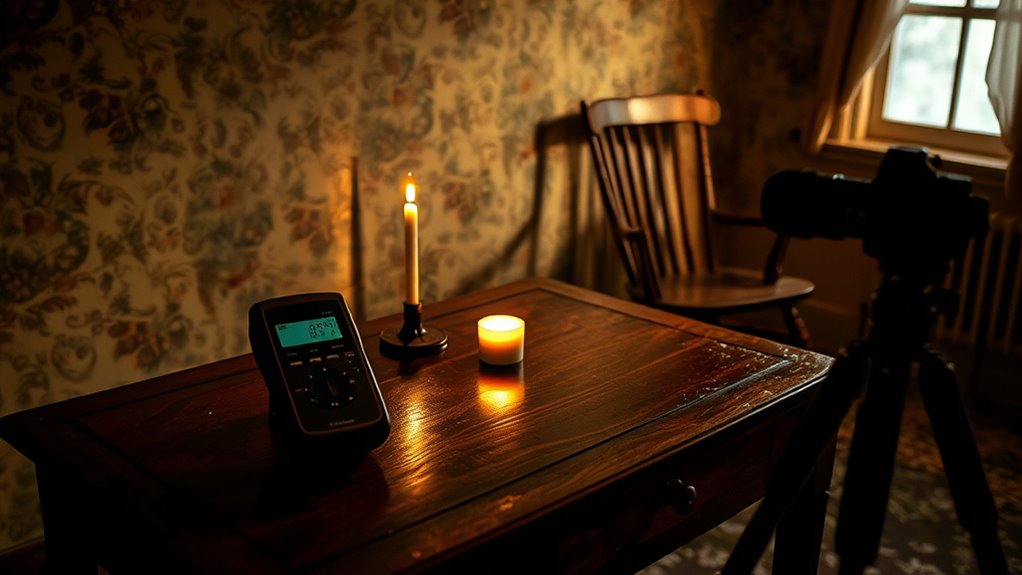
When you encounter a reported disturbance, start by analyzing possible cold drafts that might be causing those chilling sensations.
Next, investigate the source of any strange noises, as they could stem from plumbing or the natural settling of your home.
Finally, examine visual anomalies like reflections or light sources that could mislead you into thinking you’ve witnessed something supernatural.
Analyzing Cold Drafts
As you investigate reports of paranormal activity, it’s crucial to reflect on cold drafts as a potential cause for unsettling experiences. Poor insulation, cracks in walls, or faulty HVAC systems can create sudden temperature changes, leading to eerie feelings.
To effectively analyze cold drafts, consider the following:
| Source of Cold Drafts | Potential Signs |
|---|---|
| Poorly Insulated Windows | Noticeable cold spots |
| Cracks in Walls | Sudden temperature drops |
| Leaky HVAC Ductwork | Fluctuating indoor temperatures |
Using thermal cameras can help pinpoint these issues, while documenting temperature fluctuations helps correlate them with reported disturbances. This thorough examination guarantees you rule out cold drafts as a source of paranormal disturbances.
Investigating Noise Sources
Investigating noise sources is essential for disproving disturbances that might be misinterpreted as paranormal activity. Start by documenting the times and locations of disturbances, noting specific sounds or sensations you experience.
Examine environmental factors like plumbing, heating systems, or loose floorboards that can explain unusual noises. Utilize tools like high EMF meters and audio recorders to capture readings during these events, providing valuable data for analysis.
Don’t forget to check for external noise sources, such as traffic, wildlife, or weather-related sounds, which might contribute to the disturbances. Conduct a thorough analysis of the home’s layout and any alterations made over time, as structural changes can introduce new noise sources that confuse your investigation.
Examining Visual Anomalies
While visual anomalies can often spark excitement in paranormal investigations, it’s essential to approach them with a discerning eye. You might encounter orbs, mists, and shadows that seem supernatural but could simply be dust, moisture, or lighting effects.
Always analyze your photographs for reflections or light sources that could create odd visuals, as these can lead to misconceptions about paranormal phenomena. Using thermal imaging cameras can help you detect cold spots, indicating potential activity.
Motion-sensitive video cameras capture unusual shapes or movements in reported areas, lending credibility to your findings. Regularly cross-reference timestamps and environmental conditions with your recordings to rule out non-paranormal explanations, ensuring your investigation remains grounded in scientific principles.
Setting Up Motion-Sensitive Cameras
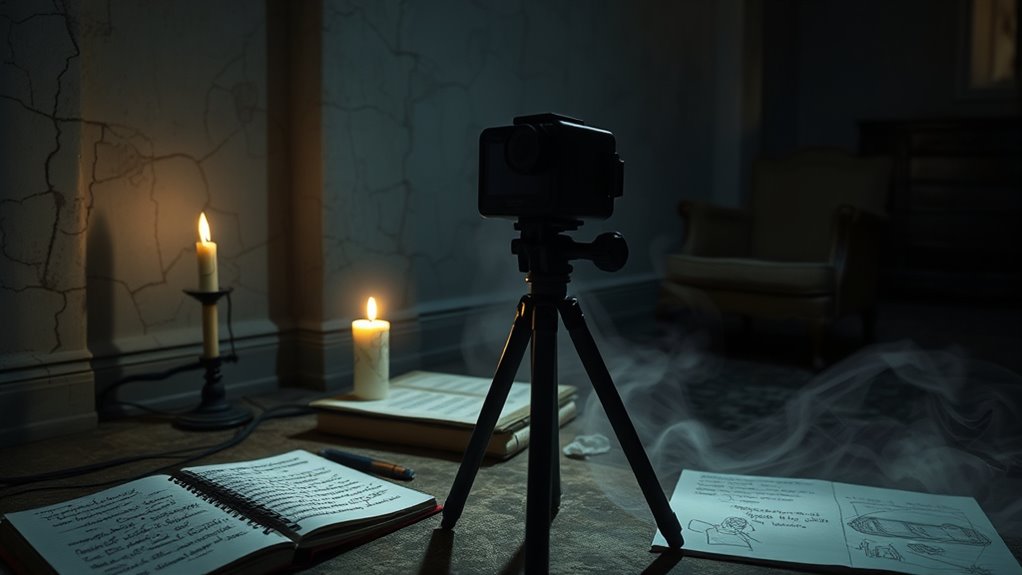
To effectively capture potential paranormal activity, you’ll want to set up motion-sensitive cameras in areas where disturbances have been reported.
These cameras should include motion detectors and temperature sensitivity features to help track cold drafts, which might indicate a ghostly presence. Position them strategically to cover all affected areas, maximizing your chances of recording unusual occurrences.
Overnight recordings are best, as most disturbances happen at night. Once you’ve set up the cameras, regularly review the footage for any unusual shapes, shadows, or movements.
This careful setup and monitoring can provide essential evidence of paranormal activity, helping you make informed conclusions about the strange happenings in your environment.
Conducting EVP Sessions

To conduct a successful EVP session, you need to prepare your equipment carefully, starting with a high-quality audio recorder.
When you ask questions, make sure they’re clear and specific, allowing time for any responses. This approach not only enhances the quality of your recordings but also increases your chances of capturing meaningful evidence.
Equipment Preparation Essentials
When you’re preparing to conduct an EVP session, having the right equipment is essential for capturing any potential paranormal activity.
To effectively record electronic voice phenomena, consider these essentials:
- High-quality audio recorder: Confirm it has good battery life and storage for lengthy sessions.
- Quiet environment: Set the recorder in an area with reported disturbances to minimize background noise.
- Avoid handling: Once set up, don’t touch the recorder to prevent interference.
After your session, listen attentively to the recordings.
Analyze them for any unexplained voices or sounds that might indicate paranormal activity.
This careful preparation can make all the difference in your EVP findings, so prioritize these steps for the best chance of success.
Questioning Techniques Strategies
How can you effectively engage with potential entities during an EVP session? As a paranormal investigator, your questioning techniques play an essential role.
Start by using a high-quality audio recorder, placing it in a stable position to minimize interference. Ask clear, concise questions and allow pauses for responses. This gives entities a chance to communicate audibly.
Maintain a calm demeanor; avoid touching the recorder once set up, as this can disrupt recordings. Encourage specific responses by requesting distinct signs from any present entities, enhancing your evidence quality.
After the session, review the recordings carefully, listening for unexplained sounds or voices that may indicate paranormal activity. This approach will heighten your chances of capturing meaningful EVPs.
Taking Visual Evidence
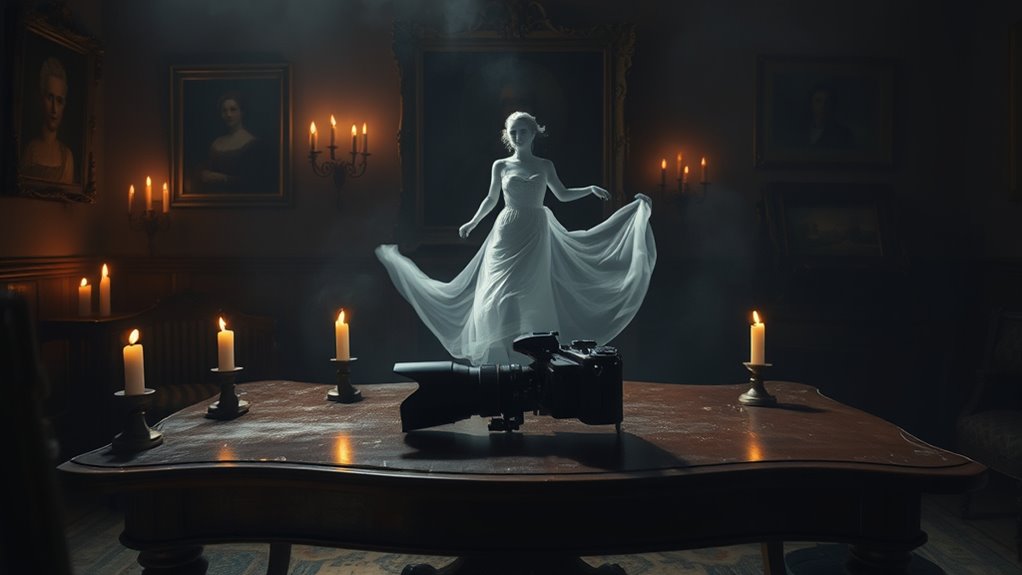
While exploring locations rumored to be haunted, capturing visual evidence is essential for validating claims of paranormal activity.
Capturing visual evidence is crucial when investigating haunted locations to substantiate claims of paranormal activity.
Utilizing the right tools can make a significant difference in your findings. Here are some key methods:
- Thermal cameras: Detect temperature fluctuations, indicating possible spirits or cold spots.
- Motion-sensitive video cameras: Capture unexplained movements in areas with reported disturbances.
- Flash photography: Document anomalies in dark settings, but be cautious of misinterpreting orbs as dust or insects.
Additionally, cross-referencing timestamps from your video cameras with audio recordings of EVPs can enhance your findings’ credibility.
Analyzing Video Footage
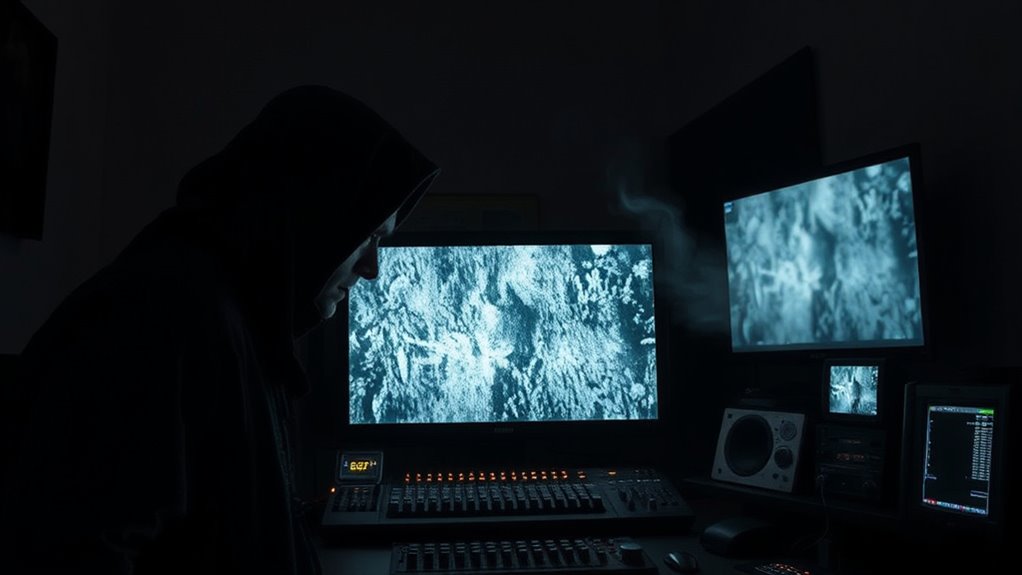
Analyzing video footage is a critical step in confirming paranormal activity, as it allows you to scrutinize recorded evidence for unusual shapes, shadows, or movements. You should look for inconsistencies in lighting or reflections that might explain the phenomena before labeling them as supernatural. Utilize thermal sensitivity features to detect temperature changes that could point to cold spots.
| Aspect | What to Look For | Purpose |
|---|---|---|
| Shapes | Unusual outlines or figures | Identify potential supernatural phenomena |
| Shadows | Inconsistent light patterns | Rule out non-paranormal explanations |
| Movements | Erratic motions | Correlate with reported activities |
| Temperature Changes | Cold spots | Confirm claims of drafts or chills |
| Timestamps | Match with reported events | Validate evidence credibility |
Compile your findings to assess the credibility of the footage.
Reviewing Audio Recordings
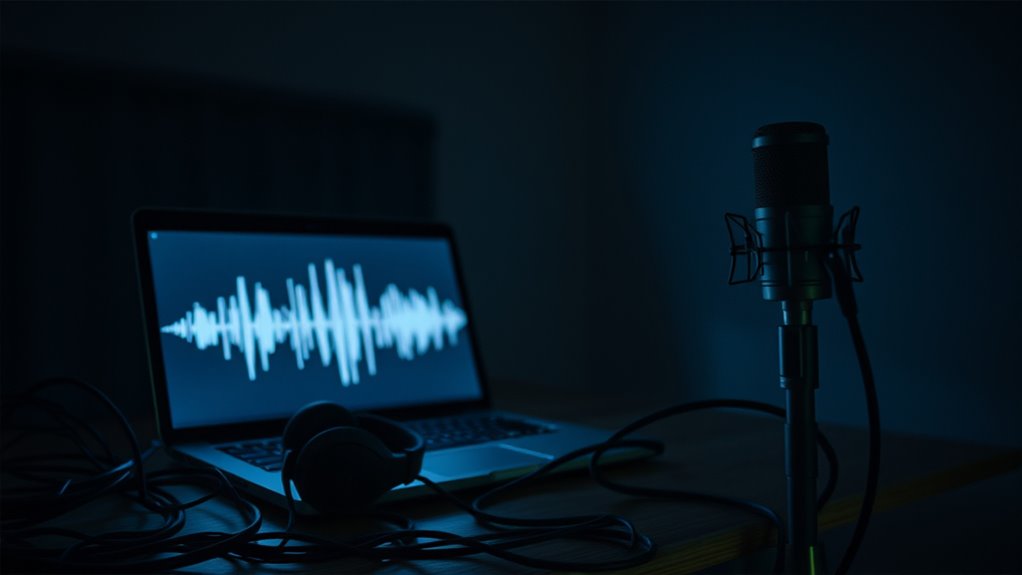
After scrutinizing video footage, the next step involves reviewing audio recordings, a key aspect of paranormal investigations.
During this phase, you’ll analyze your audio recordings for electronic voice phenomena (EVP). These voices can often be classified into three categories based on clarity:
- Class A: Clear and easily understandable
- Class B: Somewhat clear but may require interpretation
- Class C: Barely audible or difficult to discern
While listening, pay attention to unexplained sounds or voices.
It’s crucial to avoid touching the recording device once it’s set up, maintaining the integrity of the captured audio. Additionally, cross-referencing audio timestamps with visual evidence can enhance your findings, adding credibility to your investigation.
Patience is key in capturing meaningful audio during EVP sessions.
Identifying Patterns in Evidence
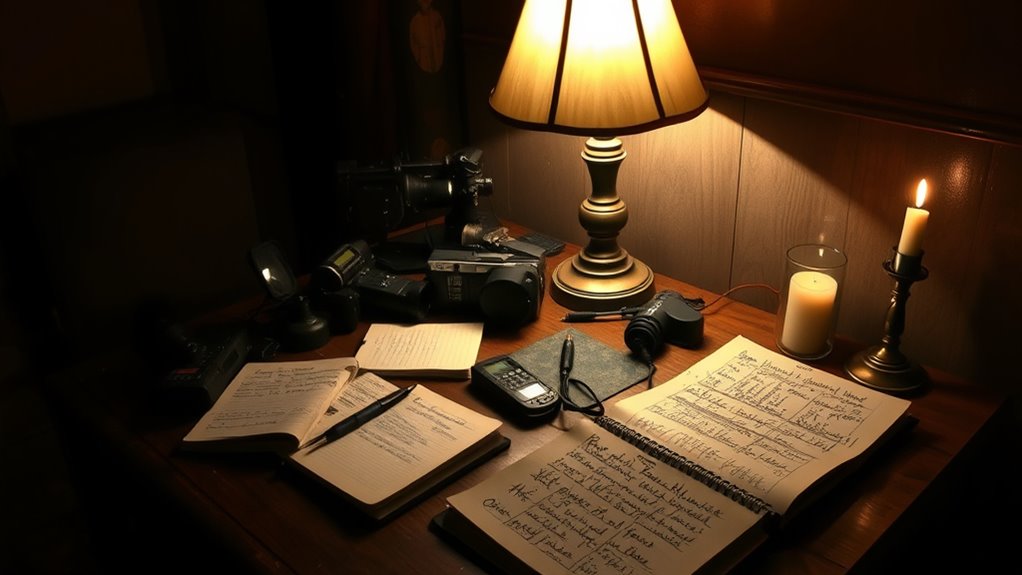
To identify patterns in evidence, you’ll want to document recurring disturbances and note any environmental influences on activity.
Look for connections between different types of evidence, like audio and visual recordings, to build a clearer picture of what’s happening.
Recurring Disturbance Instances
As you document recurring disturbances like cold chills or unexplained noises, you’ll begin to uncover patterns that may indicate hotspots of paranormal activity in a location.
By paying attention to these instances, you can enhance your investigations.
Consider these key points:
- Track specific times and locations: This helps you identify when paranormal events are more likely to occur.
- Establish a timeline: Monitoring the frequency and intensity of disturbances builds credibility for your claims.
- Analyze potential triggers: Look for environmental factors that might explain disturbances without resorting to paranormal explanations.
Environmental Influences on Activity
While exploring paranormal activity, you’ll find that environmental influences play a crucial role in shaping your experiences. Factors like temperature changes, humidity, and air pressure can greatly impact occurrences. For instance, cold drafts are commonly reported in haunted locations. High EMF readings often correlate with ghost sightings, revealing how electronics can create a paranormal atmosphere.
Here’s a table summarizing key environmental influences:
| Environmental Factor | Effect on Paranormal Activity |
|---|---|
| Temperature | Cold drafts reported |
| Humidity | Increased disturbances |
| Air Pressure | Variations in activity |
| EMF Levels | Correlates with sightings |
| Time of Year | Seasonal patterns observed |
Cross-Referencing Evidence Findings
Understanding environmental influences sets the stage for effectively cross-referencing evidence findings in paranormal investigations. By analyzing various data sources, you can identify consistent patterns that support or challenge claims of paranormal activity.
Consider focusing on:
- Timestamps from audio recordings and video footage
- Environmental data like temperature changes and EMF readings
- Clarity of Electronic Voice Phenomena (EVP)
Documenting date, time, weather conditions, and specific locations enhances the accuracy of your findings. This systematic approach helps you spot recurring incidents and may reveal areas of interest for further investigation.
Utilizing Advanced Equipment

If you’re serious about investigating paranormal activity, utilizing advanced equipment can greatly enhance your findings.
Tools like EMF detectors measure electromagnetic fields and can reveal fluctuations linked to spirits. Thermal cameras help you identify cold spots in real-time, often associated with ghostly presences.
EMF detectors and thermal cameras are essential tools for uncovering ghostly presences and identifying chilling cold spots.
SLS cameras, which create 3D models, can detect and map figures that may represent entities, offering visual proof of paranormal activity. Spirit boxes, such as the P-SB7, let you communicate with spirits by scanning radio frequencies, potentially producing messages from the beyond.
Additionally, motion detectors and surveillance devices capture unexplainable movements or sounds, providing vital evidence when you’re not present.
These advanced ghost-hunting equipment options are essential for any serious investigator.
Engaging With Historical Context

Investigating paranormal activity isn’t just about modern technology; it also involves understanding the historical context that shaped current practices.
By studying past investigations, you can appreciate how controlled conditions were essential for verifying claims. Here are some key historical points:
- The London National Laboratory of Psychical Research, established in 1926, focused on applying experimental methods to supernatural phenomena.
- The testing of mediums, like Mina ‘Margery’ Crandon in the 1920s, utilized controlled settings to assess authenticity.
- The Cottingley Fairies case illustrates the clash between public fascination and the need for rigorous scientific scrutiny.
These historical examples highlight the evolution of paranormal research and the ongoing relationship between science and the supernatural.
Understanding this context enriches your approach to testing for paranormal activity today.
Frequently Asked Questions
How to Tell if There Is Paranormal Activity?
To tell if there’s paranormal activity, pay attention to unexplained noises like creaks or whispers, and notice any sudden temperature drops.
Trust your instincts; if you feel cold chills or a sense of being watched, it might be significant.
Document everything meticulously, including times and locations, as patterns can reveal hauntings.
Keep an ear out for Electronic Voice Phenomena (EVP) and consider setting up motion-sensitive cameras to capture any unusual movements.
Is There Any Evidence of Paranormal Activity?
Yes, there’s evidence of paranormal activity that many find intriguing.
You might hear unexplained sounds or capture eerie voices on recordings, often referred to as electronic voice phenomena.
Visual evidence, like orbs or shadows, can appear in thermal images.
You may also notice unusual movements on motion-sensitive cameras.
Additionally, spikes in electromagnetic fields could indicate a ghostly presence, while documented disturbances like cold chills add to the compelling narrative of the supernatural.
What Is a Ghost Detector?
A ghost detector, or EMF meter, measures electromagnetic fields. You’d use it to identify spikes that some believe signal the presence of spirits.
Many models also check temperature, helping you spot cold spots often linked to ghost sightings. While they’re popular in paranormal investigations, their reliability is debated, as high readings may stem from natural sources like faulty wiring.
Still, they’re fun tools for exploring the unknown during your ghost-hunting adventures!
What Do You Call Someone Who Investigates the Paranormal?
They say curiosity killed the cat, but it’s also what drives you to explore the unknown. When you investigate the world of the supernatural, you’re known as a paranormal investigator or ghost hunter.
These individuals seek to uncover mysteries surrounding ghosts and unexplained phenomena. With a mix of scientific methods and personal experiences, you’ll use various tools and techniques to gather evidence and satisfy your curiosity about the afterlife.
Conclusion
In your quest for the unseen, remember the lighthouse guiding ships through fog. Just as sailors rely on its beam, let your methods illuminate the shadows of doubt. Document each whisper and flicker, but don’t let the allure of mystery lead you astray. With steady hands and a discerning heart, you’ll navigate the intricate waters of the paranormal, revealing truths hidden beneath the surface. Stay curious, but anchored in reason, and you just might find what you seek.
